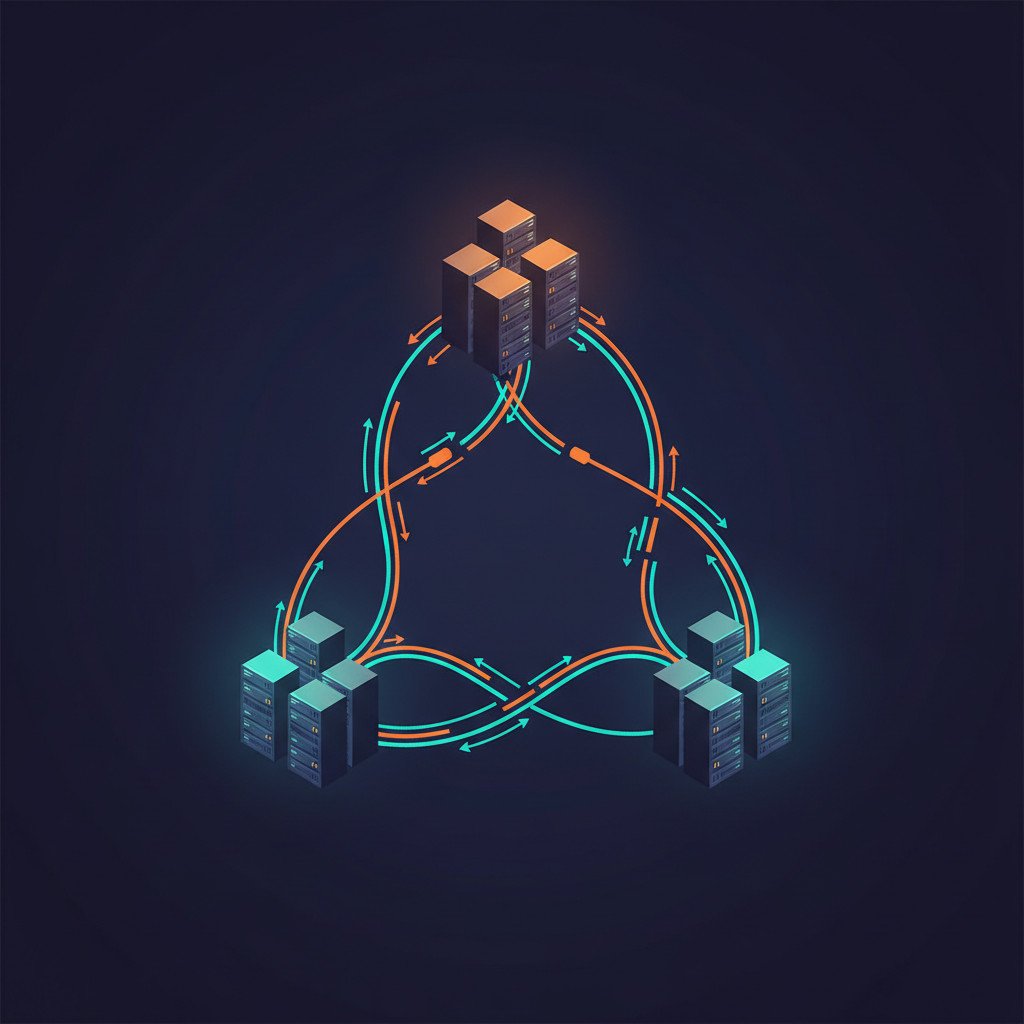NVIDIA Spectrum-X for AI Data Centres
NVIDIA Spectrum-X for AI data centres promises to redefine high performance networking for modern AI workloads. It acts as a nervous system linking GPUs, SuperNICs and Ethernet switches across massive clusters. Because training trillion parameter models needs predictable, low latency networks, networking matters more than ever. This introduction previews how Spectrum-X Ethernet and associated MGX building blocks enable reliable scale.
Spectrum-X delivers up to 95 percent effective bandwidth, while traditional Ethernet delivers far less effective throughput. Moreover, Spectrum-X pairs hardware and algorithms to optimise both intra rack and inter data centre links. It supports NVLink scale up for GPU pairs, yet also enables scale out across racks. As a result, operators see more consistent throughput and lower tail latency during large training runs.
This article unpacks Spectrum-X architecture, SuperNICs, MGX racks and the Vera Rubin designs. We compare Spectrum-X with XGS and standard Ethernet to show practical trade offs. However, we will also cover deployment patterns, open networking integrations like FBOSS and operational best practices. By the end, readers will understand how Spectrum-X helps build AI super factories and how to plan for scale.
We draw on vendor partnerships, field tests and architectural data to ground analysis. Therefore, the article balances product detail with operational guidance for engineers and architects. Read on to learn how NVIDIA Spectrum-X for AI data centres can transform fleet level efficiency.
What is NVIDIA Spectrum-X for AI data centres?
NVIDIA Spectrum-X is a purpose built Ethernet networking platform for large scale AI workloads. It bundles high performance switches, SuperNICs and algorithms to deliver predictable bandwidth and low tail latency. Because AI training stresses both bandwidth and latency, Spectrum-X targets those pain points directly. As a result, operators can scale clusters without losing effective throughput.
Core technology highlights
- SuperNIC enabled design: SuperNICs offload networking and provide smart telemetry, which reduces CPU overhead and improves packet handling.
- Spectrum-X Ethernet switches: These switches pair silicon and co packed optics to lower energy use and extend reach across racks and sites.
- Algorithm driven performance: Spectrum-X applies different algorithms for intra data centre and inter data centre links, improving effective throughput.
- MGX integration: Spectrum-X fits into NVIDIA MGX racks to combine CPUs, GPUs, storage and networking in modular blocks.
Unique features that matter for AI
- Near line rate effective bandwidth: Spectrum-X achieves up to 95 percent effective bandwidth, compared with about 60 percent for typical Ethernet. Therefore, training jobs see higher sustained throughput.
- Predictable tail latency: The platform reduces jitter and tail latency, which prevents stragglers from delaying distributed SGD and other sync points.
- Scale out and scale up: NVLink supports GPU scale up within servers, while Spectrum-X enables scale out across racks and sites.
- Open networking compatibility: Spectrum-X works with common NOS and open frameworks such as FBOSS and SONiC, which eases integration.
Performance, scalability and data throughput benefits
- Higher utilization: Because effective bandwidth rises, clusters use compute more efficiently. Consequently, less idle GPU time appears during large runs.
- Linear growth across scale: Spectrum-X keeps throughput predictable as you add more nodes. Thus, planning for thousands or millions of GPUs becomes practical.
- Lower operational cost: Co packed optics and power aware designs reduce energy per bit. Moreover, partners across the supply chain help with power and cooling designs.
- Reduced training time: With fewer network bottlenecks, end to end training jobs finish faster, which shortens iteration loops for models.
Deployment and ecosystem notes
- Major cloud and hyperscaler adoption: Meta and Oracle have announced Spectrum-X integrations for their AI data centres, showing early production interest. You can read NVIDIA’s platform overview for technical details here: NVIDIA’s platform overview.
- Industry press and launch details: NVIDIA published launch materials and press releases that describe co packed optics and scale goals: NVIDIA’s launch details.
- Complementary routing and interconnect designs: For adjacent interconnect work, see coverage of the Cisco 8223 AI data centre router as a useful comparison: Cisco 8223 AI Data Router.
In summary, Spectrum-X pairs hardware and software to give AI data centres higher effective throughput and predictable latency. Therefore, operators can build reliable, giga scale AI factories without sacrificing efficiency.

Conceptual visualization of three AI data centre clusters connected by bright neon optical links. The illustration shows server rack groups, glowing compute hubs and flowing bidirectional data lines to represent high capacity, low latency networking inspired by NVIDIA Spectrum-X.
Impact of NVIDIA Spectrum-X for AI data centres on AI workloads
NVIDIA Spectrum-X reduces network friction for demanding AI workloads. By improving effective bandwidth and cutting tail latency, it directly speeds both training and inference. For engineers and architects, this change translates into fewer stragglers, faster sync points, and higher GPU utilization.
Key workload improvements
- Distributed model training: Spectrum-X cuts jitter and tail latency. Therefore, synchronous training programs reach barrier points faster. As a result, distributed SGD spends less time waiting for slow nodes.
- Large model inference: Because throughput rises, inference clusters sustain higher query rates. Consequently, serving latency becomes more predictable for conversational agents and recommendation systems.
- Real time analytics and streaming: Low latency and reliable bandwidth improve streaming ETL and feature aggregation. Thus, data pipelines deliver fresher inputs to models.
- Reinforcement learning and robotics: Deterministic network behavior helps closed loop systems. In turn, control loops and simulators run with more consistent timing.
Technical benefits explained
- Bandwidth efficiency: Spectrum-X achieves up to 95 percent effective bandwidth. Traditional Ethernet often delivers around 60 percent effective throughput. Therefore, Spectrum-X transfers more data per unit time across the same physical links.
- Tail latency reduction: The platform applies algorithms tuned for intra centre and inter centre hops. These algorithms reduce jitter and lower the 95th and 99th percentile latencies. Consequently, distributed workloads face fewer outliers.
- Telemetry and visibility: SuperNICs and switches provide precise telemetry. Operators get flow level metrics and microburst detection, which enables faster remediation. Moreover, this telemetry aids autoscaling decisions.
- Congestion control: Spectrum-X combines hardware buffering and smart congestion algorithms. Thus, it prevents packet loss and reduces retransmits during heavy allreduce and parameter syncs.
- Energy and optical gains: Co packaged optics lower energy per bit and shorten optical paths. As a result, links consume less power and show lower propagation delay.
Quantified impact on workflows
- Faster time to train: With fewer network-induced stalls, training jobs complete in less wall clock time. For large models, even single digit percentage gains cut days from experiments. Therefore, iteration velocity improves significantly.
- Higher cluster utilization: Because effective throughput rises, clusters waste less GPU time. In practice, operators can run denser workloads or reduce fleet size while keeping throughput.
- More predictable SLOs: Production inference deployments show steadier latency curves. Thus, SLAs become easier to meet and monitor.
For technical readers seeking detail, NVIDIA provides platform documentation and launch notes that describe Spectrum-X capabilities: NVIDIA Spectrum-X Documentation and NVIDIA Spectrum-X Launch Notes.
| Category | Traditional networking (legacy Ethernet and switches) | NVIDIA Spectrum-X for AI data centres |
|---|---|---|
| Latency | Higher jitter and variable tail latency under load. | Low jitter and reduced 95th/99th percentile tail latency. |
| Bandwidth (effective) | Typical effective throughput around 50 to 65 percent. | Up to 95 percent effective bandwidth for demanding flows. |
| Scalability | Performance often degrades nonlinearly as nodes scale. | Predictable throughput as clusters grow to thousands of GPUs. |
| AI workload suitability | Adequate for small scale training and generic services. | Optimised for distributed training, large inference fleets and analytics. |
| Cost efficiency | Lower initial cost; higher total cost from wasted GPU hours. | Higher density and utilization, lowering total cost per model run. |
| Telemetry and observability | Basic counters and sampling; limited microburst detection. | Rich SuperNIC telemetry and flow level microburst visibility. |
| Congestion control | Generic algorithms; more retransmits under allreduce. | Hardware buffering and tuned congestion algorithms, fewer retransmits. |
| Power and optics | External optics increase power and reach limits. | Co packed optics reduce energy per bit and shorten optical paths. |
| Ecosystem and integration | Multiple vendor NOS; integration can be complex. | Designed for open networking; integrates with FBOSS, SONiC and MGX. |
Use this table to justify network upgrades when planning giga scale AI factories. Spectrum-X shows clear gains in throughput, latency and operational predictability.
SEO and Related Keyword Opportunities
- AI data center networking: Use this phrase in headings and alt text to match searcher intent about infrastructure and network design.
- High performance AI fabric: Include this term when describing end to end fabrics that combine Spectrum-X, NVLink and MGX for scale.
- Low latency switches: Target this keyword in sections about tail latency improvements and switch-level algorithms.
- Data throughput optimization: Use in performance deep dives and case studies that quantify gains from 95 percent effective bandwidth.
- Spectrum-X Ethernet and SuperNICs: Repeat these product terms naturally to capture product specific searches.
How These Keywords Integrate with NVIDIA Spectrum-X for AI Data Centres
- Anchor content with the main keyword: Place “NVIDIA Spectrum-X for AI data centres” in H1 and H2 tags and the first 100 words. This helps search engines prioritise the topic. Furthermore, use supporting keywords in subheadings to create a topical cluster.
- Create topical clusters: Build pages on MGX system, NVLink, FBOSS integration, and co packaged optics. Linking these pages internally increases domain relevance for AI networking queries.
- Optimize for long tail queries: Answer questions like “how to reduce tail latency in distributed training” or “best switches for large inference fleets”. These queries often convert well because they show clear intent.
- Use schema and technical metadata: Add product schema and FAQ schema for Spectrum-X features, latency figures, and compatibility notes. This improves visibility in rich results.
- Balance technical depth with readability: Write short paragraphs and bullet lists. As a result, readers and crawlers find relevant signals faster.
Practical On Page Suggestions
- Include related keywords in image alt text and captions for the Spectrum-X visual. This signals relevance for visual search and accessibility.
- Add internal links to related architecture pieces such as MGX racks and the Cisco 8223 router article to keep readers engaged. For example, see the Cisco router comparison.
- Publish a follow up case study page showing measured throughput gains and latency percentiles. Then link it from the main Spectrum-X article to improve topical authority.
These steps help search engines understand the article’s focus while keeping it useful for engineers and decision makers interested in high performance AI fabrics.

NVIDIA Spectrum-X for AI data centres: future trends and trajectory
AI networking will shift from best effort to engineered determinism. Because models grow faster than budgets, operators need networks that scale predictably. NVIDIA Spectrum-X for AI data centres sits at that intersection. It provides a foundation for future improvements in density, energy efficiency, and automation.
Emerging trends to watch
- Higher voltage power and smarter racks. As a result of 800 volt designs, racks will deliver more stable power with less waste. This trend complements Spectrum-X because it reduces thermal constraints on networking gear.
- Co packaged optics and shorter paths. Therefore, links will use less power and show lower propagation delay. That enables tighter synchronization for distributed training.
- Software defined congestion control. In addition, adaptive algorithms will tune flow behaviour for allreduce and parameter syncs. Spectrum-X already embeds tuned algorithms and will iterate rapidly.
- End to end telemetry and AI driven operations. Because SuperNICs provide detailed metrics, operations teams can apply ML to predict hotspots and schedule workloads proactively.
How NVIDIA is positioned to lead
- Holistic system focus. NVIDIA moves beyond switches to connect silicon, optics, and NICs. Consequently, the company can co design features across layers for better performance.
- Ecosystem partnerships. NVIDIA collaborates with hyperscalers and vendors on rack designs and power. Therefore, Spectrum-X benefits from integrated supply chain improvements.
- Modular MGX and Rubin architectures. These building blocks let operators mix compute, networking, and storage. As a result, deployments can evolve without full forklift upgrades.
Potential future enhancements
- Improved latency shaping algorithms for cross site syncs. This will reduce tail latency for global training jobs.
- Tighter NVLink and Ethernet co scheduling. Then, applications can balance scale up and scale out automatically.
- Native telemetry driven autoscaling. Finally, networks will trigger resource moves before SLOs degrade.
In short, NVIDIA Spectrum-X for AI data centres aligns with the next wave of AI infrastructure. With system level design and partner execution, it can help operators build resilient, energy efficient, giga scale AI factories.
Industry voices on NVIDIA Spectrum-X for AI data centres
“Trillion-parameter models are transforming data centers into giga-scale AI factories, and industry leaders like Meta and Oracle are standardizing on Spectrum-X Ethernet to drive this industrial revolution. Spectrum-X is not just faster Ethernet — it’s the nervous system of the AI factory, enabling hyperscalers to connect millions of GPUs into a single giant computer to train the largest models ever built.” — Jensen Huang, founder and CEO of NVIDIA.
This quote frames Spectrum-X as a systemic upgrade. It supports claims about scale and predictable networking. Source: NVIDIA Newsroom (see full release).
“Oracle Cloud Infrastructure is designed from the ground up for AI workloads, and our partnership with NVIDIA extends that AI leadership. By adopting Spectrum-X Ethernet, we can interconnect millions of GPUs with breakthrough efficiency so our customers can more quickly train, deploy and benefit from the next wave of generative and reasoning AI.” — Mahesh Thiagarajan, executive vice president, Oracle Cloud Infrastructure.
In context, Oracle links Spectrum-X to operational efficiency and time to model. Read Oracle and NVIDIA joint announcement for details.
“Meta’s next-generation AI infrastructure requires open and efficient networking at a scale the industry has never seen before. By integrating NVIDIA Spectrum Ethernet into the Minipack3N switch and FBOSS, we can extend our open networking approach while unlocking the efficiency and predictability needed to train ever-larger models and bring generative AI applications to billions of people.” — Gaya Nagarajan, vice president, networking engineering, Meta.
This quote highlights open networking and FBOSS integration, which matters for operators and integrators.
For verification and deeper reading, see NVIDIA’s release on Spectrum-X and coverage from industry press. NVIDIA Newsroom. Additional context: Computer Weekly. Related technical comparison: Cisco AI Data Router Comparison.
In summary, NVIDIA Spectrum-X for AI data centres delivers predictable low latency, near line rate bandwidth, and scalable interconnects that cut training time and raise GPU utilization. These gains translate into faster model iteration, fewer wasted compute hours, and lower operational cost. Because Spectrum-X couples SuperNIC telemetry with co packed optics and tuned congestion control, operators gain clearer visibility and more deterministic performance.
If you are planning an upgrade, EMP0 (Employee Number Zero, LLC) can help. As an AI and automation solutions provider, EMP0 assists businesses to implement cutting edge infrastructure like Spectrum-X to multiply revenue and optimise operations. Visit EMP0’s website for services and case studies at EMP0’s website. Also explore technical deep dives and architecture posts on the EMP0 blog. For automation playbooks and workflow examples, see EMP0’s n8n collection.
Act now to future proof your AI stack. Contact EMP0 to assess readiness, plan integration, and pilot a Spectrum-X deployment. Together, you can build efficient, giga scale AI factories that deliver measurable business value.

